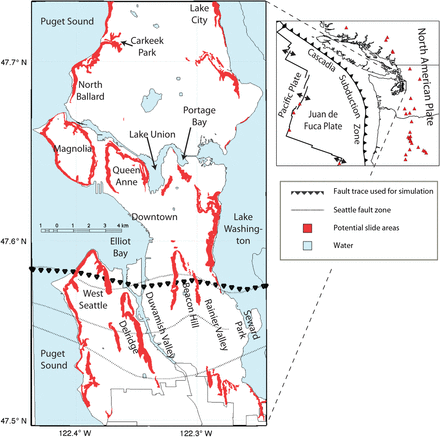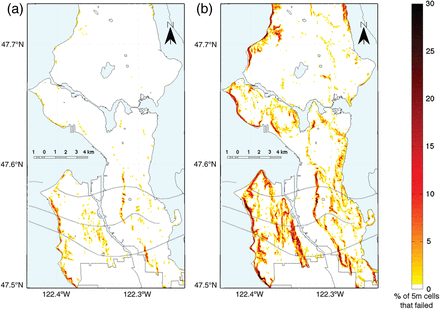23 October 2013
Review of a paper: landslide scenarios for a large Seattle earthquake
Posted by Dave Petley
![]() Regular readers will know that the lack of attention that is paid to potential and actual landslide impacts during earthquakes in upland areas is a real hobby-horse of mine. Time and again we see the situation in which there is a lack of preparedness for landslides, causing huge disruption to the response and recovery operations, even though the threat was entirely forseeable. It is pleasing to see increased interest in the science of this issue in recent years, with a succession of good papers exploring both the mechanics of the landslide process (which is a very complex problem) and the likely occurrence of landslides. This week, a paper has been electronically released on the BSSA website, to appear in a forthcoming edition of the journal, which examines the likely impact of landslides in the event of a Mw=7.0 earthquake of a “Seattle earthquake” – i.e. a quake on the Seattle Fault in Seattle, Washington. The paper, Allstadt et al. (2013) uses synthetic broadband seismograms to model shallow landslides in the area likely toi be affected by such an earthquake. Such an analysis is complex and computationally extremely intensive. I should also note that the technique uses the so-called Newmark method to model the slope behaviour. Newmark is basically the best technique that we have at our disposal at present, and so the team were right to do this, but in my view it is somewhat deficient in terms of the ways in which it models slope behaviour. We need a better technique; the trouble is that at the moment we do not have one.
Regular readers will know that the lack of attention that is paid to potential and actual landslide impacts during earthquakes in upland areas is a real hobby-horse of mine. Time and again we see the situation in which there is a lack of preparedness for landslides, causing huge disruption to the response and recovery operations, even though the threat was entirely forseeable. It is pleasing to see increased interest in the science of this issue in recent years, with a succession of good papers exploring both the mechanics of the landslide process (which is a very complex problem) and the likely occurrence of landslides. This week, a paper has been electronically released on the BSSA website, to appear in a forthcoming edition of the journal, which examines the likely impact of landslides in the event of a Mw=7.0 earthquake of a “Seattle earthquake” – i.e. a quake on the Seattle Fault in Seattle, Washington. The paper, Allstadt et al. (2013) uses synthetic broadband seismograms to model shallow landslides in the area likely toi be affected by such an earthquake. Such an analysis is complex and computationally extremely intensive. I should also note that the technique uses the so-called Newmark method to model the slope behaviour. Newmark is basically the best technique that we have at our disposal at present, and so the team were right to do this, but in my view it is somewhat deficient in terms of the ways in which it models slope behaviour. We need a better technique; the trouble is that at the moment we do not have one.
Putting those concerns to one side, the novel element of this is the use of the synthetic seismic data. However, given that this is a landslide blog I am going to leave that for the seismologists to discuss and analyse, and instead look at what the work shows us in terms of likely landslide impacts in such a Seattle earthquake. Figure 1 from the paper, shown below, is a map of the Seattle area showing in red the areas that have been identified by the city as being prone to landslides and in black triangles the Seattle Fault. The last significant earthquake on that fault was about AD900; the recurrence period of earthquakes is in the range 200 to 12,000 years:

Figure 1 from Allstadt et al. 2013. Original caption: “Map of Seattle showing location of Seattle fault zone (dotted line), frontal fault location used for rupture model for landslide simulation (line of triangles), and potential landsliding areas designated by the City of Seattle. Neighborhoods and landmarks mentioned in the text are labeled. Inset map shows regional tectonic setting and volcanoes (triangles).”
The researchers ran two different scenarios for the landslides associated with a Seattle earthquake. In the first they assumed that the earthquake occurred when conditions were dry. In this case the earthquake generated just 4,977 landslides covering a source area of about 0.2 square kilometres. On the other hand, when the scenario was run for saturated conditions – in this case they generated 30,000 landslides covering 1.9 square kilometres in the city. It has long been hypothesised that antecedent weather conditions play a strong role in determining coseismic landslide distributions – this study supports that view. Fortunately, the extreme ends of the spectrum represented by these scenarios are unlikely – the probability is that the earthquake would occur when groundwater levels are somewhere between the two.
The consequences of the landslides in either scenario would be very serious indeed. In the best case scenario, shown in the figure below from the paper, landslides would impact heavily on the coastal bluffs of Seattle and in scattered locations around the south side of the city. In the worst case scenario, also shown below, the southern half of Seattle would suffer extremely high rates of landsliding, and even the northern half of the city would be affected.

Figure 10 from Allstadt et al (2013). Original caption: Percentage of cells in each area where failures were triggered, as defined in the text for the (a) dry and (b) saturated soil conditions for the Mw 7.0 Seattle fault earthquake simulation.
The paper then considers the consequences of these landslides in terms of infrastructure impacts. The authors calculated the numbers of buildings at risk from these landslides (although not all such structures would be affected in an actual event). For even the best case scenario over 1,000 buildings lie in zones with elevated hazard ratings, of which 400 were in the two highest hazard classes. In the worst case scenario 8,000 buildings were in an elevated hazard zone, of which 5,000 were in the highest hazard classes. A further 8,500 buildings are in zones that might be affected by landslide debris runout. Of course this means that many roads, railways and pipelines are also at risk.
The authors acknowledge in the paper that because our understanding of seismically-triggered landslides is so poor there is considerable uncertainty in these analyses, and much more work is needed. I agree with this, but the research is clearly flagging a major and important hazard that deserves attention. I should also add that in one respect the research plays down the risk though. Experience from elsewhere suggests that the first really heavy rainfall event after the earthquake induces many more landslides, and that landslide activity would remain at a highly elevated level for years or even decades after a Seattle earthquake. Thus, we would expect to see many additional landslides after the main shock, and these landslides are likely to be very damaging.
Reference
Allstadt, K., Vidalem J.E., & Frankel, A.D. (2013). A Scenario Study of Seismically Induced Landsliding in Seattle Using Broadband Synthetic Seismograms Bulletin of the Seismological Society of America : 10.1785/0120130051


 Dave Petley is the Vice-Chancellor of the University of Hull in the United Kingdom. His blog provides commentary and analysis of landslide events occurring worldwide, including the landslides themselves, latest research, and conferences and meetings.
Dave Petley is the Vice-Chancellor of the University of Hull in the United Kingdom. His blog provides commentary and analysis of landslide events occurring worldwide, including the landslides themselves, latest research, and conferences and meetings.